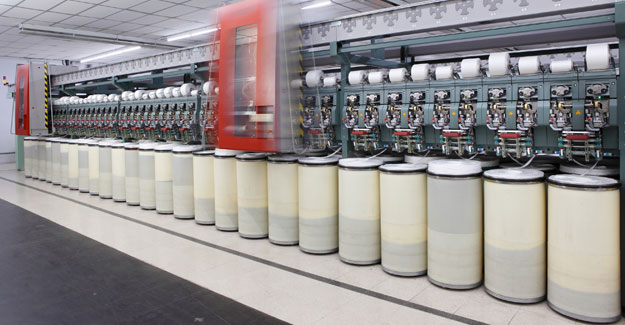
New Possibilities With Air-Jet Spinning Using Spun-Dyed Viscose Fibres
The need for sustainability and environment-friendly manufacture of textiles across the entire value chain is increasing constantly. Dyeing natural and synthetic cellulose fibres already during the fibre manufacturing instead of colouring the textile fabric is an approach to support this trend.
In a trial, Grasim Industries Limited, located in India and belonging to the Aditya Birla Group (ABG), and Rieter tested the impact of different spinning systems on processing spun-dyed viscose fibres to define the ideal spinning process as well as the advantages and risks. Grasim Industries is one of the largest manufacturers of viscose fibres and together with Rieter they have a joint cooperation toexplore the production of best quality air-jet spun yarns and fabrics made from viscose fibres and its blends.
[caption id="attachment_19915" align="alignright" width="300"]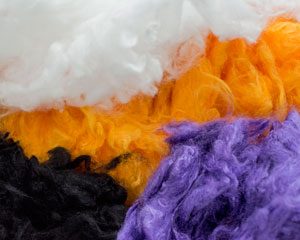 Spun-dyed and undyed viscose fibers in different colors ( Fig. 1)[/caption]
For the trial spun-dyed viscose fibres in the colours black, violet, and yellow with different yarn counts were processed with the air-jet spinning machine J 26 (Fig. 1). Viscose in raw white and the conventional ring spinning system served as a basis for comparison. In order to be able to assess the yarn quality completely, woven and knitted fabrics have been produced, too.
Air-jet and ring yarns perform as expected
When comparing the produced air-jet and ring yarns, the measured unevenness of air-jet yarns is higher by around 15% (Fig. 2). As it could be expected, the air-jet yarns also perform worse concerning the yarn tenacity values compared to the ring yarn. In addition, the tenacity of the dyed air-jet yarns is 7-14%lower than the raw white, depending on the colour. Nevertheless, all air-jet yarns still meet the requirements for further downstream processing. When it comes to hairiness, however, the air-jet yarn performs much better than the ring yarn. This is an important criterion for the later fabric stage in terms of pilling and colour fastness.
[caption id="attachment_19916" align="alignnone" width="700"]
Spun-dyed and undyed viscose fibers in different colors ( Fig. 1)[/caption]
For the trial spun-dyed viscose fibres in the colours black, violet, and yellow with different yarn counts were processed with the air-jet spinning machine J 26 (Fig. 1). Viscose in raw white and the conventional ring spinning system served as a basis for comparison. In order to be able to assess the yarn quality completely, woven and knitted fabrics have been produced, too.
Air-jet and ring yarns perform as expected
When comparing the produced air-jet and ring yarns, the measured unevenness of air-jet yarns is higher by around 15% (Fig. 2). As it could be expected, the air-jet yarns also perform worse concerning the yarn tenacity values compared to the ring yarn. In addition, the tenacity of the dyed air-jet yarns is 7-14%lower than the raw white, depending on the colour. Nevertheless, all air-jet yarns still meet the requirements for further downstream processing. When it comes to hairiness, however, the air-jet yarn performs much better than the ring yarn. This is an important criterion for the later fabric stage in terms of pilling and colour fastness.
[caption id="attachment_19916" align="alignnone" width="700"]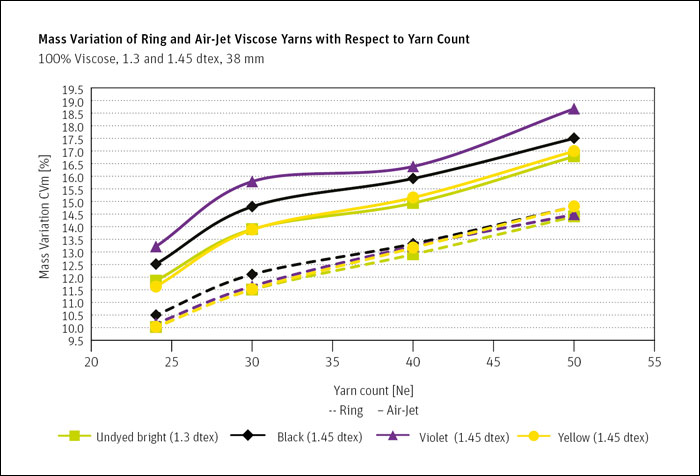 The air-jet yarn has a higher unevenness due to its special structure. (Fig 2)[/caption]
The air-jet fabrics show a highly enhanced evenness
The examination of the yarns indicated that the ring yarn exhibits better results on all the test criteria except hairiness. But at the fabric stage, this is not reflected in the same way. Quite the opposite, a more even appearance in the fabric structure with air-jet yarns can be identified compared to the ring yarn. One reason for this is the special yarn structure of air-jet yarn, which results from the bigger yarn diameter, the twisted fibres around the core fibres, and the lower hairiness.
Air-jet spinning and spun-dyed fibres harmonize particularly well
The ring spinning system applies higher fibre-metal friction at the technology components compared to air-jet spinning, and, as a result, more fibres along the yarn strand axis are pushed up. In contrast to that, the fibre stress with air-jet spinning is lower.This is important for spun-dyed fibres because an examination with the Scanning Electron Microscope has shown that coloured fibres have more colour pigments on the surface and thus a higher fibre-to-fibre friction which is directly proportional to the fibre-metal friction.
This positive effect of air-jet spinning is especially prominent with spun-dyed viscose fibres. These fibres result in a fabric with better optical evenness, which cannot be reached with the raw white fibres to this extent (Fig. 3). Therefore, it can be concluded that the processing of spun-dyed fibres in combination with the air-jet spinning process creates new and additional benefits.
[caption id="attachment_19917" align="aligncenter" width="600"]
The air-jet yarn has a higher unevenness due to its special structure. (Fig 2)[/caption]
The air-jet fabrics show a highly enhanced evenness
The examination of the yarns indicated that the ring yarn exhibits better results on all the test criteria except hairiness. But at the fabric stage, this is not reflected in the same way. Quite the opposite, a more even appearance in the fabric structure with air-jet yarns can be identified compared to the ring yarn. One reason for this is the special yarn structure of air-jet yarn, which results from the bigger yarn diameter, the twisted fibres around the core fibres, and the lower hairiness.
Air-jet spinning and spun-dyed fibres harmonize particularly well
The ring spinning system applies higher fibre-metal friction at the technology components compared to air-jet spinning, and, as a result, more fibres along the yarn strand axis are pushed up. In contrast to that, the fibre stress with air-jet spinning is lower.This is important for spun-dyed fibres because an examination with the Scanning Electron Microscope has shown that coloured fibres have more colour pigments on the surface and thus a higher fibre-to-fibre friction which is directly proportional to the fibre-metal friction.
This positive effect of air-jet spinning is especially prominent with spun-dyed viscose fibres. These fibres result in a fabric with better optical evenness, which cannot be reached with the raw white fibres to this extent (Fig. 3). Therefore, it can be concluded that the processing of spun-dyed fibres in combination with the air-jet spinning process creates new and additional benefits.
[caption id="attachment_19917" align="aligncenter" width="600"]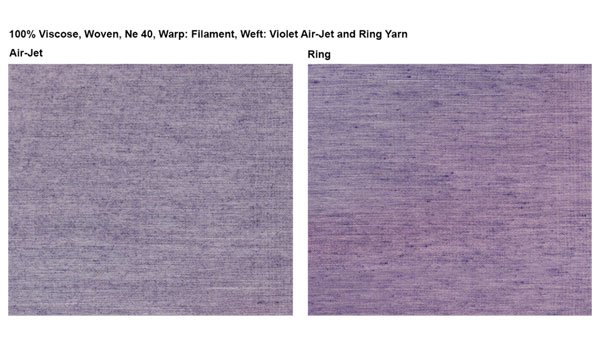 The air-jet fabric has a superior appearance. (Fig. 3)[/caption]
Higher efficiency and less pollution with spin-dyeing
Birla SpunshadesTM Fibres from Grasim Industries and the Rieter air-jet spinning process of the latest J 26 machine generation (Fig. 4.) enable the production of spun-dyed staple fibre yarns in optimal quality and at lowest yarn manufacturing costs. The yarn manufacturing costs are between 20-25% lower with air-jet spinning than with the ring spinning technology, due to the higher productivity.
The dyeing of the textile fabric is an expensive process and the estimated cost is approximately 1 US dollar per kilogram. Subsequently, applied chemicals for dyeing the textile fabrics increase the price of the process and also pollute the environment.
The direct addition of colour pigments into the spinning solution during fibre manufacture is more cost-effective and more environmentally-friendly. Spun-dyed fibres can already save up to 50% colouring agents depending on the colour compared to the process of colouring the fabric. The production costs per kg of yarn thus are below those of the conventional dyeing process of textile fabrics. The potential for the future use of spun-dyed viscose is calculated to be 20% of the entire man-made cellulose market.
The air-jet fabric has a superior appearance. (Fig. 3)[/caption]
Higher efficiency and less pollution with spin-dyeing
Birla SpunshadesTM Fibres from Grasim Industries and the Rieter air-jet spinning process of the latest J 26 machine generation (Fig. 4.) enable the production of spun-dyed staple fibre yarns in optimal quality and at lowest yarn manufacturing costs. The yarn manufacturing costs are between 20-25% lower with air-jet spinning than with the ring spinning technology, due to the higher productivity.
The dyeing of the textile fabric is an expensive process and the estimated cost is approximately 1 US dollar per kilogram. Subsequently, applied chemicals for dyeing the textile fabrics increase the price of the process and also pollute the environment.
The direct addition of colour pigments into the spinning solution during fibre manufacture is more cost-effective and more environmentally-friendly. Spun-dyed fibres can already save up to 50% colouring agents depending on the colour compared to the process of colouring the fabric. The production costs per kg of yarn thus are below those of the conventional dyeing process of textile fabrics. The potential for the future use of spun-dyed viscose is calculated to be 20% of the entire man-made cellulose market.
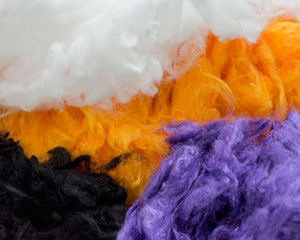
Textile Excellence
If you wish to Subscribe to Textile Excellence Print Edition, kindly fill in the below form and we shall get back to you with details.








